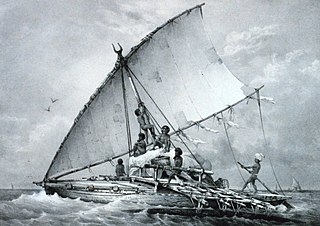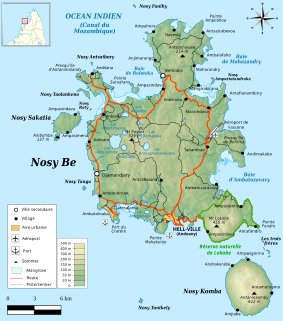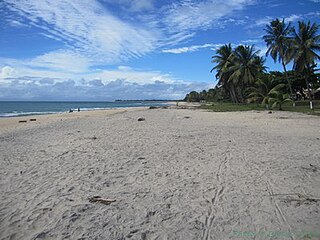
Madagascar, officially the Republic of Madagascar, and previously known as the Malagasy Republic, is an island country in the Indian Ocean, approximately 400 kilometres off the coast of East Africa. At 592,800 square kilometres (228,900 sq mi) Madagascar is the world's second-largest island country. The nation comprises the island of Madagascar and numerous smaller peripheral islands. Following the prehistoric breakup of the supercontinent Gondwana, Madagascar split from the Indian subcontinent around 88 million years ago, allowing native plants and animals to evolve in relative isolation. Consequently, Madagascar is a biodiversity hotspot; over 90% of its wildlife is found nowhere else on Earth. The island's diverse ecosystems and unique wildlife are threatened by the encroachment of the rapidly growing human population and other environmental threats.

The history of Madagascar is distinguished clearly by the early isolation of the landmass from the ancient supercontinent containing Africa and India, and by the island's late colonization by human settlers arriving in outrigger canoes from the Sunda islands between 200 BC and 500 AD. These two factors facilitated the evolution and survival of thousands of endemic plant and animal species, some of which have gone extinct or are currently threatened with extinction due to the pressures of a growing human population. Over the past two thousand years the island has received waves of settlers of diverse origins including Austronesian, Bantu, Arab, South Asian, Chinese and European. The majority of the population of Madagascar today is a mixture of Austronesian, Bantu, North Indian, Arab and Somali settlers.
Société Nationale Malgache de Transports Aériens S.A., operating as Air Madagascar, is an airline based in Antananarivo, Madagascar. It is the national airline of Madagascar operating services to Europe, Asia and neighbouring African and Indian Ocean island destinations, from its main base, Ivato International Airport in Antananarivo. It also operates an extensive domestic network.

Nosy Be[ˌnusʲ ˈbe] is an island off the northwest coast of Madagascar. Nosy Be is Madagascar's largest and busiest tourist resort. It has an area of 320.02 square kilometres (123.56 sq mi), and its population was 109,465 according to the provisional results of the 2018 Census.

Ankarana Special Reserve in northern Madagascar was created in 1956. It is a small, partially vegetated plateau composed of 150-million-year-old Middle Jurassic limestone. With an average annual rainfall of about 2,000 millimetres (79 in), the underlying rocks are susceptible to erosion, thereby producing caves and underground rivers—a karst topography. The rugged relief and the dense vegetation have helped protect the region from human intrusion.

The Indian Ocean Island Games is a multi-sport event held every four years among athletes from Indian Ocean island nations. The Games was created by the International Olympic Committee (IOC) in 1977 and currently gather the island nations and territories of Mauritius, Seychelles, Comoros, Madagascar, Mayotte, Réunion and the Maldives. The number of athletes who participate has increased over the years, it went from 1000 athletes in 1979 to over 1500 participants in 2003 and 2007 and over 2000 participants in 2019.

Morondava[murunˈdav̥] is a city located in Menabe Region, of which it is the capital, in Madagascar. It is located in the delta of the Morandava River at 20°17′5″S44°19′3″E.

Nepenthes madagascariensis is one of two Nepenthes pitcher plant species native to Madagascar, the other being N. masoalensis.

Sava is a region of northern Madagascar. Its capital is Sambava. Until 2009 Sava belonged to Antsiranana Province. The region is situated at the northern part of the east coast of Madagascar. It is bordered by Diana to the north, Sofia to the west, and Analanjirofo to the south. The population was 1,123,013 in 2018 and the total area is 25,518 km2 (9,853 sq mi). The region contains wild areas such as Marojejy National Park.

Madagascar is divided into 22 regions (faritra). These formerly second-tier administrative divisions became the first-level administrative divisions when the former six provinces were dissolved on 4 October 2009:

Vatovavy-Fitovinany is a region located in southeast Madagascar. Its capital is Manakara. It is inhabited by the Antemoro people.

The brown-tailed mongoose, Malagasy brown-tailed mongoose, or salano is a species of mammal in the family Eupleridae. It is endemic to Madagascar. Its natural habitat is subtropical or tropical dry forests. It is threatened by habitat loss.

Haute Matsiatra is a region in Madagascar. It borders Amoron'i Mania region in north, Vatovavy-Fitovinany in east, Ihorombe in south and Atsimo-Andrefana in west. The capital of the region is Fianarantsoa, and the population was 1,447,296 in 2018. The area is 21,080 km2 (8,139 sq mi).

Anosy is one of the 22 regions of Madagascar. It is located in the southeast of the country, on the eastern side of what was once the Toliara Province. The name Anosy means "island(s)" in Malagasy.

Malagasy is an Austronesian language and the national language of Madagascar. Most people in Madagascar speak it as a first language, as do some people of Malagasy descent elsewhere.

Hypogeomys australis is an extinct rodent from central and southeastern Madagascar. First described in 1903, it is larger than its close relative, the living Hypogeomys antimena, which occurs further west, but otherwise similar. Average length of the femur is 72.1 mm, compared to 63.8 mm in H. antimena. One of the few extinct rodents of Madagascar, it survived to at least around 1536 BP based on radiocarbon dating. Little is known of its ecology, but it may have lived in burrows like its living relative and eaten some arid-adapted plants.

Isalorhynchus is an extinct genus of hyperodapedontine rhynchosaur from the late Triassic period of Toliara Province, southwestern Madagascar. It is known from the holotype MDE-R18, a nearly complete maxilla and from other specimens from the same locality, Malio River area. It was found in the Makay Formation of the Morondava Basin. It was first named by Eric Buffetaut in 1983 and the type species is Isalorhynchus genovefae. The majority of Isalorhynchus specimens are isolated jaw bones, but two nearly complete skeletons were found in 1998. Langer et al., 2000 concluded that Isalorhynchus is a synonym of Hyperodepedon and referred it to a new species of Hyperodepedon. Whatley, 2005 retained this genus as valid with a description of new materials in her PhD thesis. Montefeltro et al., 2010 and Langer et al., 2010 accepted Isalorhynchus as valid genus.

Désiré Tsarahazana is a Malagasy prelate of the Catholic Church. He has been Archbishop of Toamasina since 2010 but served in that see prior to its elevation since 2008. He became a Cardinal in 2018.

Narindasaurus is a genus of turiasaurian sauropod dinosaur from the Middle Jurassic Isalo III Formation of Madagascar. The type species, N. thevenini was formally described by Royo-Torres et al. in 2020. The holotype, which consists of one specimen, is currently stored at the Muséum national d’Histoire naturelle and has been since 1906 or 1907.


















